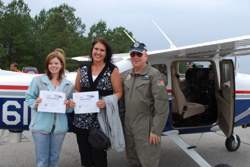 Capt. Donnie Todd with teachers Romona Matin (right) and Kelly Roberson (left), holding their flight certificates upon landing.
Capt. Donnie Todd with teachers Romona Matin (right) and Kelly Roberson (left), holding their flight certificates upon landing.
Of the 17 elementary school teachers who gathered April 18 at Alabama’s Bessemer Airport, only one had flown in a small aircraft.
By the time the teachers returned to the airport after hour-long flights in Cessnas, they couldn’t wait to do it again.
The Shelby County educators participated in the Civil Air Patrol’s (CAP) Fly-a-Teacher Program, which aims to reach the next generation of aviators—children—by turning on their teachers to flight.
The event paid immediate dividends. When Somer Miller showed her second-grade class a videotape she made, they “were amazed that we were flying. It has already gotten them interested in flying as a career,” she said in an e-mail.
CAP considers flight an ideal platform for conveying to teachers the applicability of aerospace to such subjects as mathematics, science, and meteorology, said Rick Kilgore, a member of CAP Squadron 132 and an AOPA Airport Support Network volunteer, who arranged the Alabama program.
Participants attended a 30-minute introduction and hour-long debriefing. In between, they broke up into pairs, headed out to the airplanes to be oriented on the instrument panel, and took to the air.
“They were introduced to an airplane: how it flies, turns, or banks,” said Kilgore. “It’s as realistic as we can make it.”
Kilgore arranged for his and five nearby CAP squadrons to provide the eight pilots and airplanes needed. Fly-a-Teacher typically runs monthly across the state, depending on demand, he said.
“I think that it’s a win-win [situation] for teachers in the community and pilots involved in CAP. We get to establish relationships with some highly motivated teachers who’ll share their enthusiasm with their students, introduce the importance of flying and aerospace, and, hopefully, motivate them to pursue a career in flying and aerospace,” Kilgore explained.
“That’s important because we are seeing fewer and fewer people pursue [such] careers, and there’s a need for pilots and air traffic controllers. It plants the seed in the students.”
Kilgore and Austin Landry, another CAP pilot, pointed out a more immediate benefit: building an appreciation among both the teachers and the pupils’ parents for general aviation and community airports.
Charlotte Draper, the county school system’s assistant superintendent for curriculum and instruction, said that she was gratified by county principals’ receptivity to the program when she first proposed recruiting teachers. CAP will run another Fly-a-Teacher session later in May for the 18 educators unable to participate the first time.
Members of the initial group “were so excited about getting that hands-on field experience,” Draper said. “Because they [could] experience that, they will be able to integrate some of the principles and concepts of math into their daily lessons. For instance, students don’t understand why they have to learn geometry. But when you have to learn angles and how it applies to space, you can [relate to] it better.”
Draper also mentioned the value of a pilot’s presentation on Bernoulli’s theory of lift. “That’s something many teachers never learned before,” she said. “It helps you understand how a plane stays in the air. G-forces, centrifugal forces—those are things teachers may not have thought about. Any time teachers can deepen their knowledge or content, students will benefit.”
For Miller, soaring into the sky with Fly-a-Teacher underlined a more profound lesson that she adopted as a cancer survivor.
“After having cancer, you say things like, ‘I want to live my life,’ ” she wrote. “Well, this ranks way up there on the living list.”


